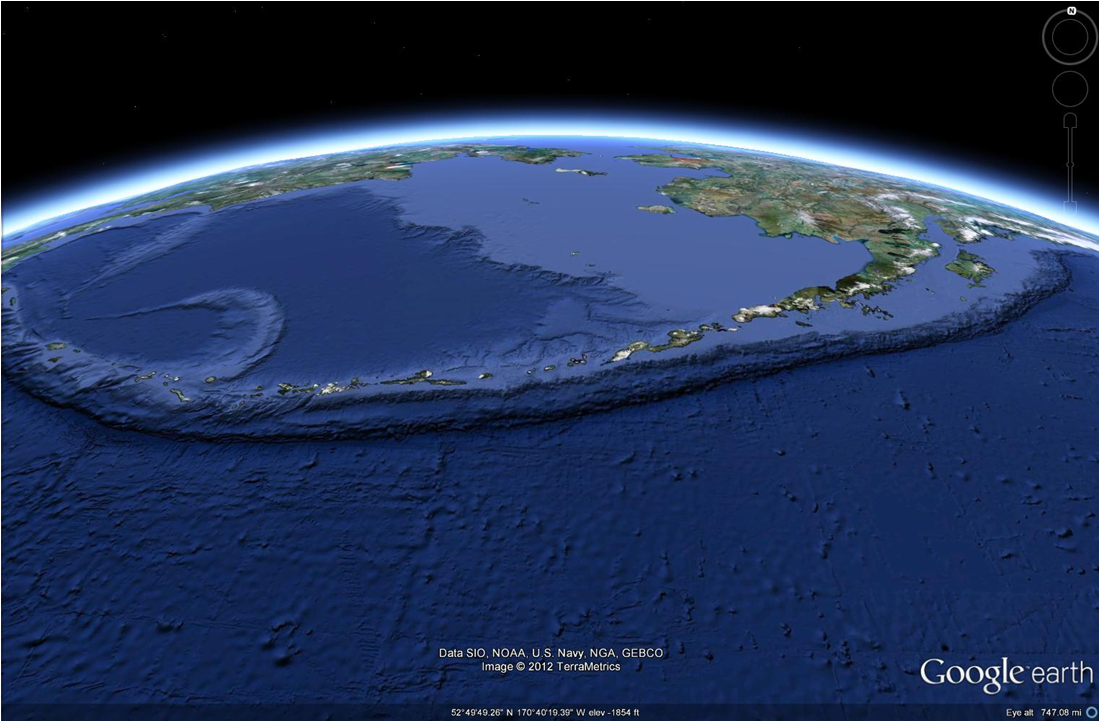Difference between revisions of "Subduction Zone Dynamics in the Mantle and at the Earth's Surface"
| Line 14: | Line 14: | ||
2. The lithosphere is non-Newtonian and exhibits strain weakening behavior, this can lead to strain localization and slab detachment. Strain rate is normally greatest in the subduction hinge therefore weakening and detachment would probably occur there. | 2. The lithosphere is non-Newtonian and exhibits strain weakening behavior, this can lead to strain localization and slab detachment. Strain rate is normally greatest in the subduction hinge therefore weakening and detachment would probably occur there. | ||
| − | '''1. Introduction: ''' [[File:aleutian.png|500px|thumb|Figure 1 | + | '''1. Introduction: ''' [[File:aleutian.png|500px|thumb|Figure 1: The center of the Aleutian Megathrust is not greatly influenced by 3D corner effects and therefore can be generally defined in 2D.]] |
The surface of the Earth takes many varying shapes, from high craggy peaks and steep gorges to rolling hills and flat coastal plains. But how and why does the Earth's surface takes its form? There are many processes that play an active role in the creation of topography and landforms, but in this module we will explore the role of mantle advection as the primary mechanism behind surface deformation (Figure 1). First, I will discuss our physical understanding of mantle dynamics, then we will use a physical model to explore the sensitivity of surface shape to various rheological conditions in the lithosphere and underlying mantle. | The surface of the Earth takes many varying shapes, from high craggy peaks and steep gorges to rolling hills and flat coastal plains. But how and why does the Earth's surface takes its form? There are many processes that play an active role in the creation of topography and landforms, but in this module we will explore the role of mantle advection as the primary mechanism behind surface deformation (Figure 1). First, I will discuss our physical understanding of mantle dynamics, then we will use a physical model to explore the sensitivity of surface shape to various rheological conditions in the lithosphere and underlying mantle. | ||
| + | |||
| + | '''2. Physics''' | ||
| + | A thorough understanding of surface deformation requires a thorough study of the coupling between lithosphere and the underlying mantle. We will apply the Navier-Stokes equation to define fluid movement in the Earth. For our purposes, let’s approximate the rheological properties of the lithosphere and mantle as high viscosity, incompressible fluids with no elasticity. This means that we assume the elastic and plastic properties of the lithosphere are insignificant and volumetrically dominated by the viscous behavior below, at least for the large spatial scales and long timescales we are interested in. I will now go into more detail on the derivation of Navier-Stokes, the basic equation used to define fluid flow. | ||
| + | |||
| + | '''2.1. Navier-Stokes derivation''' | ||
| + | How is the Earth like a fluid? Fluids are able to flow, or internally deform, when a force is applied on them. Below its frictional exterior, the Earth can readily be defined as a high viscosity fluid. This force can take the form of a loading stress, where the fluid experiences pressure due to the loading of more fluid above it | ||
Revision as of 00:46, 14 September 2015
Subduction zone dynamics in the mantle and at Earth's surface
An educational module for the University of Maine School of Earth and Climate Sciences courses in Geophysics and Fluid Dynamics
Created by Sam Roy (Samuel.g.roy@maine.edu) on 4/28/2012 Last edited on 8/2015
Two main hypotheses to explore:
1. Mantle advection controls surface deformation through mechanical coupling of lithosphere and asthenosphere.
2. The lithosphere is non-Newtonian and exhibits strain weakening behavior, this can lead to strain localization and slab detachment. Strain rate is normally greatest in the subduction hinge therefore weakening and detachment would probably occur there.
1. Introduction:The surface of the Earth takes many varying shapes, from high craggy peaks and steep gorges to rolling hills and flat coastal plains. But how and why does the Earth's surface takes its form? There are many processes that play an active role in the creation of topography and landforms, but in this module we will explore the role of mantle advection as the primary mechanism behind surface deformation (Figure 1). First, I will discuss our physical understanding of mantle dynamics, then we will use a physical model to explore the sensitivity of surface shape to various rheological conditions in the lithosphere and underlying mantle.
2. Physics A thorough understanding of surface deformation requires a thorough study of the coupling between lithosphere and the underlying mantle. We will apply the Navier-Stokes equation to define fluid movement in the Earth. For our purposes, let’s approximate the rheological properties of the lithosphere and mantle as high viscosity, incompressible fluids with no elasticity. This means that we assume the elastic and plastic properties of the lithosphere are insignificant and volumetrically dominated by the viscous behavior below, at least for the large spatial scales and long timescales we are interested in. I will now go into more detail on the derivation of Navier-Stokes, the basic equation used to define fluid flow.
2.1. Navier-Stokes derivation
How is the Earth like a fluid? Fluids are able to flow, or internally deform, when a force is applied on them. Below its frictional exterior, the Earth can readily be defined as a high viscosity fluid. This force can take the form of a loading stress, where the fluid experiences pressure due to the loading of more fluid above it